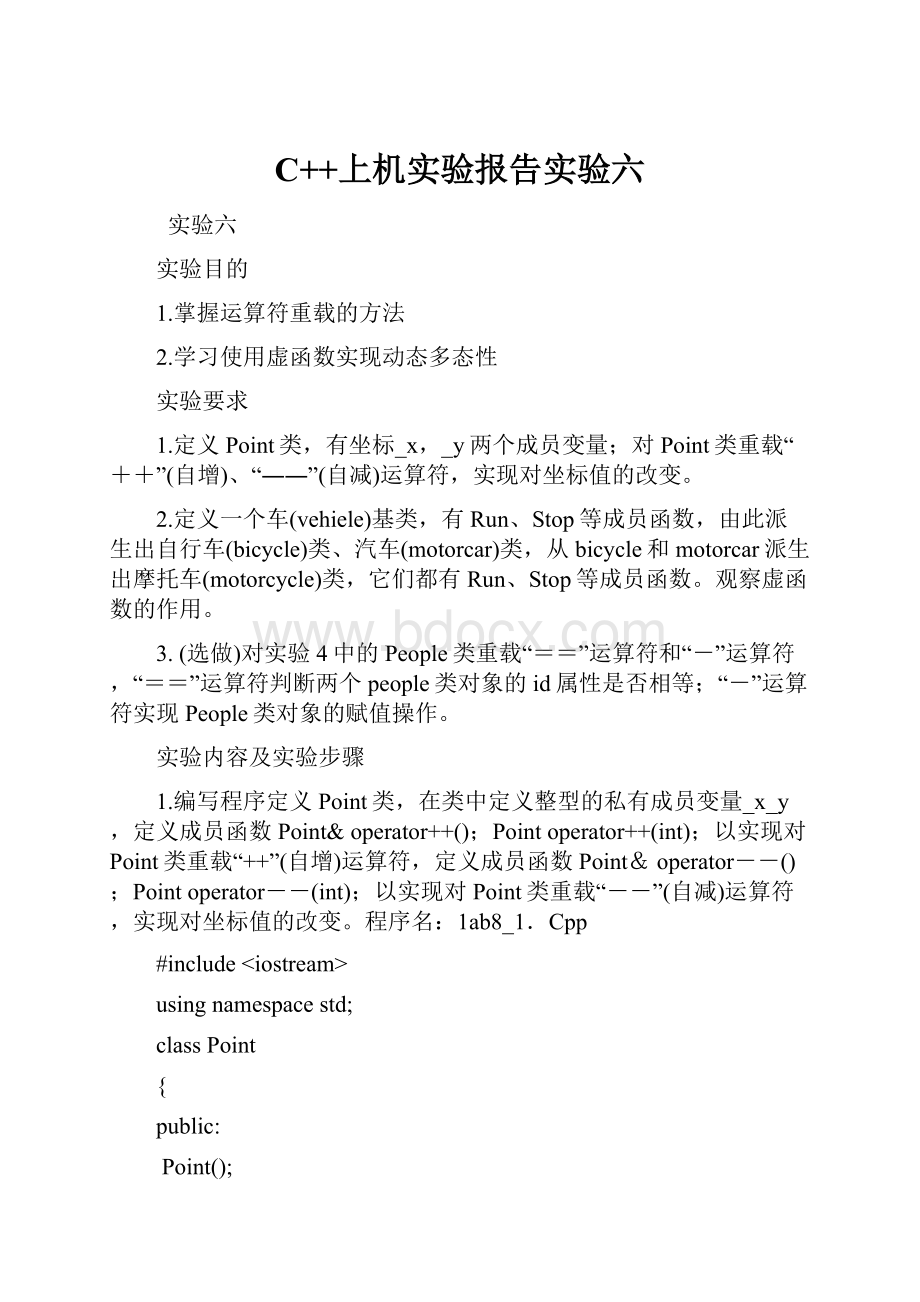C++上机实验报告实验六.docx
《C++上机实验报告实验六.docx》由会员分享,可在线阅读,更多相关《C++上机实验报告实验六.docx(12页珍藏版)》请在冰豆网上搜索。

C++上机实验报告实验六
实验六
实验目的
1.掌握运算符重载的方法
2.学习使用虚函数实现动态多态性
实验要求
1.定义Point类,有坐标_x,_y两个成员变量;对Point类重载“++”(自增)、“――”(自减)运算符,实现对坐标值的改变。
2.定义一个车(vehiele)基类,有Run、Stop等成员函数,由此派生出自行车(bicycle)类、汽车(motorcar)类,从bicycle和motorcar派生出摩托车(motorcycle)类,它们都有Run、Stop等成员函数。
观察虚函数的作用。
3.(选做)对实验4中的People类重载“==”运算符和“-”运算符,“==”运算符判断两个people类对象的id属性是否相等;“-”运算符实现People类对象的赋值操作。
实验内容及实验步骤
1.编写程序定义Point类,在类中定义整型的私有成员变量_x_y,定义成员函数Point&operator++();Pointoperator++(int);以实现对Point类重载“++”(自增)运算符,定义成员函数Point&operator--();Pointoperator--(int);以实现对Point类重载“--”(自减)运算符,实现对坐标值的改变。
程序名:
1ab8_1.Cpp
#include
usingnamespacestd;
classPoint
{
public:
Point();
Point(intx,inty);
~Point(){}//Point类析构函数
Point&operator++();//公有成员函数
Pointoperator++(int);
Point&operator--();
Pointoperator--(int);
voidShow();
private:
int_x;//私有数据成员
int_y;
};
Point:
:
Point(){//Point类构造函数
_x=0;_y=0;}
Point:
:
Point(intx,inty)//Point类构造函数
{
_x=x;
_y=y;
}
Point&Point:
:
operator++()//重载后置++运算符为Point类成员函数
{
_x++;
_y++;
}
PointPoint:
:
operator++(int)//重载前置++运算符为Point类成员函数
{
Pointold=*this;
++(this->_x);
++(this->_y);
returnold;
}
Point&Point:
:
operator--()//重载后置--运算符为Point类成员函数
{
_x--;
_y--;
}
PointPoint:
:
operator--(int)//重载前置--运算符为Point类成员函数
{
Pointold=*this;
--(this->_x);
--(this->_y);
returnold;
}
voidPoint:
:
Show()//输出Point的坐标值
{
cout<<_x<<","<<_y<<")"<}
intmain()
{
Pointa(2,3);//定义一个Point类对象a
Pointb=a++;//定义Point类对象b并用a++初始化b
Pointc=++a;//定义Point类对象c并用++a初始化c
Pointd=--a;//定义Point类对象d并用--a初始化d
Pointe=a--;//定义Point类对象e并用a--初始化e
cout<<"Pointa(";
a.Show();//输出a的坐标
cout<<"Pointb(";
b.Show();//输出b的坐标
cout<<"Pointc(";
c.Show();//输出c的坐标
cout<<"Pointd(";
d.Show();//输出d的坐标
cout<<"Pointe(";
e.Show();//输出e的坐标
return0;
}
运行结果:
2编写程序定义一个车(vehicle)基类,有Run、Stop等成员函数,由此派生出自行车(bicycle)类、汽车(motorcar)类,从bicycle和motorcar派生出摩托车(motorcycle)类,它们都有Run、Stop等成员函数。
在main()函数中定义vehicle、bicycle、motorcar、motorcycle的对象,调用其Run()、Stop()函数,观察其执行情况。
再分别用vehicle类型的指针来调用这几个对象的成员函数,看看能否成功;把Run、Stop定义为虚函数,再试试看。
程序名:
lab8_2.cpp
#include
usingnamespacestd;
classvehicle//基类vehicle
{
public:
vehicle(){}
~vehicle(){}
virtualvoidRun(){cout<<"Thevehicleisrunning!
"<virtualvoidStop(){cout<<"Thevehiclehasstopped!
"<};
classbicycle:
virtualpublicvehicle//定义派生类bicycle,声明基类为派生类的虚基类
{
public:
voidRun(){cout<<"Thebicycleisrunning!
"<voidStop(){cout<<"Thebicyclehasstopped!
"<bicycle(){}
~bicycle(){}
};
classmotorcar:
virtualpublicvehicle//定义派生类motorcar,声明基类为派生类的虚基类
{
public:
voidRun(){cout<<"Themotorcarisrunning!
"<voidStop(){cout<<"Themotorcarhasstopped!
"<motorcar(){}
~motorcar(){}
};
classmotorcycle:
publicbicycle,publicmotorcar//以bicycle类和motorcar类作为基类派生新类motorcycle
{
public:
voidRun(){cout<<"Themotorcycleisrunning!
"<voidStop(){cout<<"Themotorcyclehasstopped!
"<};
intmain()
{
vehiclea;//定义vehicle类的一个对象a
vehicle*p;//定义一个vehicle类的指针
bicycleb;//定义bicycle类的对象b
motorcarc;//定义motorcar类的对象c
motorcycled;//定义motorcycle类的对象d
a.Run();
a.Stop();
b.Run();
b.Stop();
c.Run();
c.Stop();
d.Run();
d.Stop();
p=&a;//使指针p指向vehicle类对象a
p->Run();//通过指针调用vehicle类成员函数
p->Stop();
p=&b;//使指针p指向bicycle类对象b
p->Run();//通过指针调用bicycle类成员函数
p->Stop();
p=&c;//使指针p指向motorcar类对象c
p->Run();//通过指针调用motorcar类成员函数
p->Stop();
p=&d;//使指针指向motorbicycle类对象d
p->Run();//通过指针调用motorcycle类成员函数
p->Stop();
return0;
}
运行结果:
3.(选做)对实验4中的People类重载“==”运算符和“-”运算符,“==”运算符判断两个people类对象的id属性是否相等;“-”运算符实现People类对象的赋值操作。
源程序:
#include
#include
usingnamespacestd;
classBirthday{
public:
Birthday(intYear,intMonth,intDay);//构造函数
Birthday(){}//构造函数
~Birthday(){}//析构函数
Birthday(Birthday&p);//复制构造函数
intshowBirthday(){
cout<intenter();
private:
intyear,month,day;
};
Birthday:
:
Birthday(Birthday&p){
year=p.year;
month=p.month;
day=p.day;
}
Birthday:
:
Birthday(intYear,intMonth,intDay)//Birthday类构造函数
{
year=Year;
month=Month;
day=Day;
}
intBirthday:
:
enter(){
cout<<"生日:
";
cin>>year>>month>>day;
}
classpeople{//定义people类
public:
people(){}//people类构造函数
~people(){}//people类析构函数
people(people&p);
peopleoperator==(people&);
peopleoperator-(people&);
intshow();
intenter();
private:
stringnumber,id,sex;//字符串类型变量数据成员
Birthdayp1;//Birthday类数据成员
};
intpeople:
:
show()
{
cout<<"\n性别"<cout<cout<<"生日";
p1.showBirthday();//调用Birthday类成员函数
cout<<"身份证号"<}
intpeople:
:
enter(){
p1.enter();
cout<<"性别:
";
cin>>sex;
cout<<"编号:
";
cin>>number;
cout<<"身份证号:
";
cin>>id;
}
people:
:
people(people&p):
p1(p.p1)//people类复制构造函数
{
number=p.number;
sex=p.sex;
id=p.id;
}
peoplepeople:
:
operator==(people&V)//重载==运算符成员函数
{
if(id==V.id)
{
cout<<"havethesameid!
"<}
else
{cout<<"havedifferentid!
"<}
peoplepeople:
:
operator-(people&U)//重载-运算符成员函数
{
number=U.number;//使用字符串赋值运算符
sex=U.sex;
id=U.id;
p1=U.p1;
return*this;//返回this指针
}
intmain()
{
intt;
peoplep[2];//定义对象数组p[2]
for(t=0;t<2;t++)//输入对象数组成员信息
{
cout<<"输入第"<p[t].enter();
}
for(t=0;t<2;t++)//输出对象数组成员信息
{
cout<<"\n第"<"<p[t].show();
}
peoplep3;//定义people类的对象p3
p3-p[1];//使用重载运算符将p[1]赋给p3
cout<<"\n第3个人员信息如下:
"<p3.show();
cout<<"p[0],p[1]";
p[0]==p[1];//使用重载运算符-判断p[0]和p[1]的id是否相等
return0;
}
运行结果:
思考题
1.如何将一个运算符重载为类的成员函数?
一般语法形式:
返回类型operator运算符(形参表)
{
函数体
}
函数的参数个数比原来的曹祖数个数要少一个(后置“++”,“--”除外)。
2.如何将一个运算符重载为类的友元函数?
一般形式:
friend返回类型operator运算符(形参表)
{
函数体
}
运算所需的操作数都需要通过函数的形参表传递,在形参表中形参从左至右的顺序就是运算符操作数的顺序,仅在需要访问类的私有成员或保护成员时才定义为友元函数。
3.如何实现运行时刻的多态?
通过继承和虚函数实现。
心得体会:
掌握了运算符重载的方法;运算符重载可以重载为类成员函数和非成员函数;学会了使用继承和虚函数实现运行时刻的多态;在实现动态多态时,必须使用基类类型的指针或引用,是该指针指向基类的不同派生类的对象,并通过该指针指向虚函数才能实现动态的多态性。
如果未声明为虚函数,则普通的派生类的新成员函数会覆盖基类同名成员函数,将不能实现运行时刻多态性。